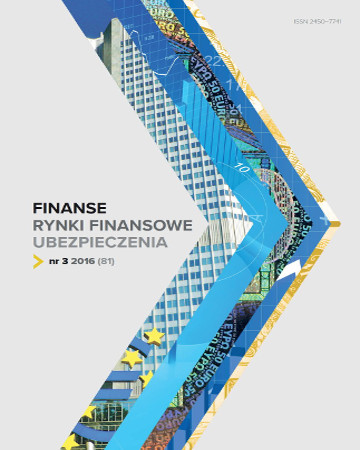
ISSN: 2450-7741
OAI
DOI: 10.18276/frfu.2017.1.85-10


Issue archive /
1/2017 (85)
Trade Finance in the Polish Corporate Sector: Balancing Growth and Financing Constraints
| Authors: |
Paweł
Mielcarz
Akademia Leona Koźmińskiego, Katedra Finansów Dmytro Osiichuk Akademia Leona Koźmińskiego w Warszawie |
| Keywords: | trade finance receivables overtrading financing constraints |
| Data publikacji całości: | 2017 |
| Page range: | 10 (107-116) |
Abstract
The paper studies the determinants of trade credit in the Polish corporate sector. In addition to the readily understandable transaction motive, we investigate the influence of the company’s liquidity, leverage and access to capital markets on its willingness to grant trade credit. Our findings suggest that firms actively adjust their trade receivables in order to avoid potential problems related to overtrading. We also find that more leveraged and more financially constrained companies are less likely to grant trade credit. Additionally, the paper studies the influence of the crisis settings on the dynamics of trade credit. We find that the outbreak of the crisis of 2008 caused companies to relax their trade credit policies which may speak in favour of the channelling theory of trade credit. The paper contributes to the on-going discussion on working capital management in the emerging economies.
Download file
Article file
Bibliography
| 1. | Bastos, R., Pindado, J. (2013). Trade credit during a financial crisis: A panel data analysis. Journal of Business Research, 66 (5), 614–620. |
| 2. | Brennan, M., Maksimowic, V., Zechner, J. (1988). Vendor financing. Journal of Finance, 43 (5), 1127–1141. |
| 3. | Carvalho, C., Schiozer, R. (2015). Determinants of Supply and Demand for Trade Credit by Micro, Small and Medium-Sized Enterprises. Revista Contabilidade & Finanças, 26 (68). DOI: 10.1590/1808-057x201500940. |
| 4. | Cegłowski, B., Wnuczak, P. (2010). Advanced techniques of planning of accounts receivable and accounts payable. Zeszyty Naukowe Uniwersytetu Szczecińskiego, 587, Finanse, Rynki Finansowe, Ubezpieczenia, 323–336. |
| 5. | Chant, E., Walker, D. (1988). Small business demand for trade credit. Applied Economics, 20, 861–876. |
| 6. | Danielson, M., Scott, G. (2004). Bank loan availability and trade credit demand. The Financial Review, 39, 579–600. |
| 7. | Devereux, M., Schiantarelli, F. (1990). Investment, financial factors, and cash flow: Evidence from UK panel data. In: R. Hubbard (ed.), Asymmetric Information, Corporate Finance and Investment (pp. 279–306). Chicago: University of Chicago Press. |
| 8. | Emery, G. (1984). A pure financial explanation for trade credit. The Journal of Financial and Quantitative Analysis, 19 (3), 271–285. |
| 9. | Fabbri, D., Klapper, L. (2008). Market Power and the Matching of Trade Credit Terms. The World Bank. |
| 10. | Ferrando, A., Mulier, K. (2013). Do firms use the trade credit channel to manage growth? Journal of Banking & Finance, 37 (8), 3035–3046. |
| 11. | Kling, G., Paul, S., Gonis, E. (2014). Cash holding, trade credit and access to short-term bank finance. International Review of Financial Analysis, 32, 123–131. |
| 12. | Ng, C., Smith, J., Smith, R. (1999). Evidence on the determinants of credit terms used in interfirm trade. The Journal of Finance, 54 (3), 1109–1129. |
| 13. | Petersen, M., Rajan, R. (1997). Trade credit: theories and evidence. The Review of Financial Studies, 10 (3), 661–691. |
| 14. | Schwartz, R. (1974). An Economic Model of Trade Credit. Journal of Financial and Quantitative Analysis, 9 (4), 643–657. |
| 15. | Seifert, D., Seifert, R., Protopappa-Sieke, M. (2013). A review of trade credit literature: Opportunities for research in operations. European Journal of Operational Research, 231, 245–256. |
| 16. | Smith, J. (1987). Trade credit and informational asymmetry. The Journal of Finance, 42 (4), 863–872. |
| 17. | Summers, B., Wilson, M. (2002). An empirical investigation of trade credit demand. International Journal of the Economics of Business, 9 (2), 257–270. |
| 18. | Wnuczak, P. (2014). Modified liquidity ratio as an alternative to traditional financial liquidity indicators. Optimum. Studia Ekonomiczne, 4 (70), 192–211. |
| 19. | Yazdanfar, D., Ohman, P. (2015). The impact of credit supply on sales growth: Swedish evidence. International Journal of Managerial Finance, 11 (3), 329–340. |